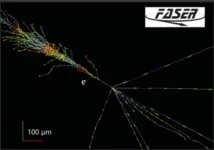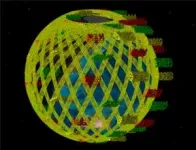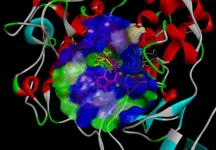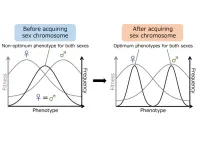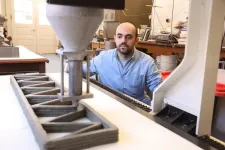(Press-News.org)
Neutrinos are fundamental particles in the Standard Model of particle physics, notable for their extremely small masses and weak interactions with matter. They are important for answering fundamental questions about the universe, including why particles have mass and why there is more matter than antimatter. Despite being abundant, their weak interactions make their detection difficult, and hence they are called “ghost particles.” At any given moment, numerous neutrinos freely pass through the Earth and our bodies, which originate from the Sun or cosmic rays. Understanding their rare interactions with matter is crucial for obtaining a more complete picture of particle physics and the universe.
There are three types, or flavors, of neutrinos: electron neutrinos (νe), muon neutrinos (νμ), and tau neutrinos (ντ). So far, most neutrinos studied by researchers have been low-energy neutrinos. To date, neutrino interaction cross sections, which is the probability of a neutrino interacting with a target particle, had not been measured at energies above 300 gigaelectronvolts (GeV) for electron neutrinos and between 400 GeV and six teraelectronvolts (6000 GeV) for muon neutrinos.
In a groundbreaking study, a team of researchers led by Associate Professor Akitaka Ariga from the Graduate School of Science, Chiba University, Japan, also affiliated with the Laboratory for High Energy Physics, University of Bern, Switzerland, and Associate Professor Tomoko Ariga from the Faculty of Arts and Science, Kyushu University, Japan, utilized the Forward Search Experiment (FASER) at CERN’s Large Hadron Collider (LHC), to achieve the first direct observation of high energy electron and muon neutrino interactions at a particle collider. The team included Dr. Ken Ohashi from the Laboratory for High Energy Physics at the University of Bern, Dr. Hiroaki Kawahara from the Faculty of Arts and Science at Kyushu University, and Project-specific Assistant Professor Daiki Hayakawa from the Graduate School of Science, Chiba University, along with other members of the FASER collaboration. Their findings were published in the journal Physical Review Letters on July 11, 2024.
One of the primary objectives of FASER is the study of high-energy neutrinos produced in the LHC’s proton-proton (pp) collisions using the dedicated FASERν detector. Dr. Akitaka Ariga explains, “With FASERν, charged particle tracks produced by neutrino interactions in the detector can be reconstructed with sub-micron precision. This allows us to identify electron and muon charged-current (CC) neutrino interactions and the measurement of neutrino interaction cross-sections in the currently unexplored TeV energy range.”
The FASERν emulsion detector is made of 730 layers of interleaved tungsten plates and emulsion films, with a total target mass of 1.1 tons. The researchers analyzed a subset of the exposed detector volume, corresponding to a mass of 128.6 kg, for high-energy neutrinos from the LHC pp collisions. After applying strict criteria, selecting events with electrons or muons with an energy above 200 GeV, four electron neutrino interaction candidate events and eight muon neutrino interaction candidate events were observed. These interactions had high statistical significance (5.2σ for electron neutrinos and 5.7σ for muon neutrinos), meaning they are highly unlikely to be random background fluctuations and therefore represent actual neutrinos.
The neutrinos detected in the study had energies in the teraelectronvolts range, the highest ever detected from an artificial source. This study marks the first measurement of neutrino interaction cross-sections in the unexplored energy range of 560–1740 GeV for electron neutrinos and 520–1760 GeV for muon neutrinos. Additionally, the measured interaction cross-sections were consistent with Standard Model predictions.
Highlighting the significance of the study, Dr. Akitaka Ariga says, “These results demonstrate the capability of studying flavor-tagged neutrino interactions at TeV energies with the FASERν emulsion-based detector at the LHC. This marks the first ever physics result on neutrinos from a particle collider, a breakthrough in particle physics that could revolutionize the strategy of large-scale experimental research in the field.”
About Associate Professor Akitaka Ariga
Akitaka Ariga is currently an Associate Professor at the Graduate School of Science, Chiba University, Japan. He obtained his MS and Ph.D. degrees from Nagoya University in 2004 and 2008, respectively. He is also the leader of the FASER group at the University of Bern’s Laboratory for High Energy Physics (LHEP). He has about 300 publications with over 13000 citations. He also received the 2023 Chiba University Advanced Academic Award for Pioneering the Frontier of High Energy Neutrino Using Colliders. His research interests include neutrinos, particle physics, nuclear physics, cosmic rays, and astrophysics.
END
Melanin protects the skin—the body's largest organ and a vital component of the immune system—from the damaging effects of ultraviolet (UV) radiation. When the skin is exposed to UV radiation, melanin production is stimulated in melanocytes, with tyrosinase playing a key role in the biosynthetic pathway. However, disruptions in this pathway caused by UV exposure or aging can lead to excess melanin accumulation, resulting in hyperpigmentation. To address this, tyrosinase inhibitors that suppress melanin synthesis have become valuable in the cosmetic industry. Unfortunately, some of these compounds, ...
In an examination of the genetic material found in historic potato leaves, North Carolina State University researchers reveal more about the tit-for-tat evolutionary changes occurring in both potato plants and the pathogen that caused the 1840s Irish potato famine.
The study used a targeted enrichment sequencing approach to simultaneously examine both the plant’s resistance genes and the pathogen’s effector genes – genes that help it infect hosts – in a first-of-its-kind analysis.
“We use small pieces of historic leaves with the pathogen ...
Caltech researchers have developed a new method to measure soil moisture in the shallow subterranean region between the surface and underground aquifers. This region, called the vadose zone, is crucial for plants and crops to obtain water through their roots. However, measuring how this underground moisture fluctuates over time and between geographical regions has traditionally relied on satellite imaging, which only gives low-resolution averages and cannot penetrate below the surface. Additionally, moisture within the vadose zone changes rapidly—a thunderstorm can saturate a region that dries ...
AURORA, Colo. (August 5, 2024) – In a first-of-its-kind study, a cohort of researchers, led by the University of Colorado Anschutz Medical Campus, evaluated the effects of state-level insulin out-of-pocket costs across states and payers and over time. The team found that state-level caps on insulin out-of-pocket costs do not significantly increase insulin claims for patients with Type 1 or patients using insulin to manage Type 2 diabetes. Study results could help inform policies aimed at better delivering cost-capped insulin to patients struggling with insulin affordability.
Approximately ...
Parkinson’s disease is a neurodegenerative disease caused by the loss of neurons that produce dopamine, a neurotransmitter involved in motor control and cognitive function. As the global population ages, the number of Parkinson's disease patients is rapidly increasing. Parkinson's disease is induced by neuronal damage due to excessive production of reactive oxygen species.
Suppression of reactive oxygen species generation is essential because it is fatal to dopaminergic neurons that manage dopamine neurotransmitters. ...
Light pollution disrupts circadian rhythms and ecosystems worldwide – but for plants, dependent on light for photosynthesis, its effects could be profound. Now scientists writing in Frontiers in Plant Science have found that exposure to high levels of artificial light at night makes tree leaves grow tougher and harder for insects to eat, threatening urban food chains.
“We noticed that, compared to natural ecosystems, tree leaves in most urban ecosystems generally show little sign of insect damage. We were curious as to why,” said corresponding author Dr Shuang Zhang of the Chinese Academy of Sciences. “Here we show that in ...
Mental health screenings must be incorporated in routine prostate cancer diagnoses say University of South Australia researchers. The call follows new research that shows men need more supports both during and immediately after a diagnosis of prostate cancer.
Funded by Movember, the UniSA study tracked the scale and timing of mental health issues among 13,693 South Australian men with prostate cancer, finding that 15% of prostate cancer patients began mental health medications directly after a prostate cancer diagnosis, with 6% seeking help from mental health ...
WASHINGTON – Three high-impact steps could be taken by global health leaders to reshape the global regulatory framework and help address the pressing need for equitable access to diagnostics, therapeutics, and vaccines during public health emergencies, say a Georgetown global health law expert and a medical student.
In their “Perspective” published today in the New England Journal of Medicine, Georgetown School of Health professor Sam Halabi, JD, and George O’Hara, a Georgetown medical student and David E. Rogers Student ...
Tokyo, Japan – Researchers from Tokyo Metropolitan University have taken a big step in solving the mystery around why animals evolve sex chromosomes. It had long been proposed that sex chromosomes evolve to reduce “sexual conflict,” the evolution of features which are sub-optimal for either sex. By using fruit flies, the team showed that genes on newly formed neo-sex chromosomes in fruit flies tend to evolve “sex-biased genes” which give sex-specific phenotypes.
Chromosomes are neatly packaged bundles of DNA that carry all the genetic material of an organism. While prokaryotes ...
A research team led by engineers at the University of Virginia School of Engineering and Applied Science is the first to explore how an emerging plant-based material, cellulose nanofibrils, could amplify the benefits of 3D-printed concrete technology.
“The improvements we saw on both printability and mechanical measures suggest that incorporating cellulose nanofibrils in commercial printable materials could lead to more resilient and eco-friendly construction practices sooner rather than later,” said Osman E. Ozbulut, a professor in the Department of Civil and Environmental ...
